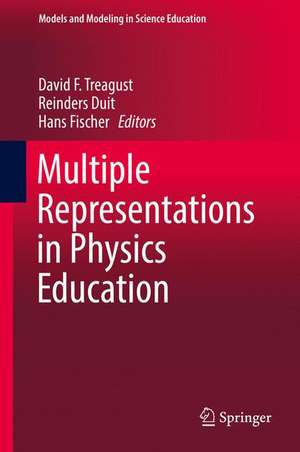Multiple Representations in Physics Education: Models and Modeling in Science Education, cartea 10
Editat de David F. Treagust, Reinders Duit, Hans E. Fischeren Limba Engleză Hardback – 3 aug 2017
| Toate formatele și edițiile | Preț | Express |
|---|---|---|
| Paperback (1) | 563.96 lei 38-45 zile | |
| Springer International Publishing – 11 sep 2018 | 563.96 lei 38-45 zile | |
| Hardback (1) | 954.14 lei 6-8 săpt. | |
| Springer International Publishing – 3 aug 2017 | 954.14 lei 6-8 săpt. |
Preț: 954.14 lei
Preț vechi: 1163.58 lei
-18% Nou
Puncte Express: 1431
Preț estimativ în valută:
182.57€ • 190.62$ • 151.10£
182.57€ • 190.62$ • 151.10£
Carte tipărită la comandă
Livrare economică 04-18 aprilie
Preluare comenzi: 021 569.72.76
Specificații
ISBN-13: 9783319589121
ISBN-10: 3319589121
Pagini: 347
Ilustrații: XI, 322 p. 94 illus.
Dimensiuni: 155 x 235 mm
Greutate: 0.69 kg
Ediția:1st ed. 2017
Editura: Springer International Publishing
Colecția Springer
Seria Models and Modeling in Science Education
Locul publicării:Cham, Switzerland
ISBN-10: 3319589121
Pagini: 347
Ilustrații: XI, 322 p. 94 illus.
Dimensiuni: 155 x 235 mm
Greutate: 0.69 kg
Ediția:1st ed. 2017
Editura: Springer International Publishing
Colecția Springer
Seria Models and Modeling in Science Education
Locul publicării:Cham, Switzerland
Cuprins
Chapter 1 Multiple Representations in Physics And Science Education – Why Should we Use Them? Maria Opfermann, Annett Schmeck and Hans E. Fischer.- Section A. Multiple Representations: Focus on Models and Analogies, Reinders Duit.- Chapter 2 Teaching and Learning Representations in Upper Secondary Physics, Per Morten Kind, Carl Angell, Øystein Guttersrud.- Chapter 3 Integrating Computational Artifacts into the Multi-Representational Toolkit of Physics Education, Brian E. Gravel, Michelle H. Wilkerson.- Chapter 4 Evaluating Multiple Analogical Representations from Students' Perceptions, Jing-Wen Lin, Mei-Hung Chiu.- Section B Multiple Representations: Focus on Multiple Modes, Hans Fischer.- Chapter 5 Social Semiotics in University Physics Education, John Airey, Cedric Linder.- Chapter 6 Learning Optics with Multiple Representations: Not as Simple as Expected, Yen-Ruey Kuo, Mihye Won, Marjan Zadnik, Salim Siddiqui, David Treagust.- Chapter 7 Enacting a Representation Construction Approach to Teaching And Learning Astronomy, Peter Hubber, Russell Tytler.- Chapter 8 Learning about Forces using Representations, Pasi Nieminen, Antti Savinainen, Jouni Viiri.- Chapter 9 The Conceptual elements of Multiple Representations: A Study of Textbooks’ Representations of Electric Current, Chee Leong Wong, Hye-Eun Chu.- Section 3: Multiple Representations: Focus on Reasoning and Representational Competence, David Treagust.- Chapter 10 Representational Competence, Understanding of Experiments, Phenomena and Basic Concepts in Geometrical Optics: A Representational Approach, Andreas Müller, Rosa Hettmannsperger, Jochen Scheid, Wolfgang Schnotz.- Chapter 11 Understanding and Promoting Effective Use of Representations in Physics Learning, Pat Kohl, Noah Finkelstein.- Chapter 12 The Role of Representations in Students’ Explanations of Four Phenomena in Physics : Dynamics, thermal physics and electromagnetic induction and superposition, Jennifer Yeo, John K. Gilbert.- Chapter 13Cross Referencing to Co-Construct Knowledge about Global Heat Transfer in an Online Learning Environment: Learning with Multiple Visualizations, Florence R. Sullivan, W. Richards Adrion, Dave Hart, Christopher N. Hill, K.C. Nat Turner, Jeff Xavier, Youngkwan Cha, Sangchil Lee, Bradford Wheeler.- Index.
Textul de pe ultima copertă
This volume is important because despite various external representations, such as analogies, metaphors, and visualizations being commonly used by physics teachers, educators and researchers, the notion of using the pedagogical functions of multiple representations to support teaching and learning is still a gap in physics education. The research presented in the three sections of the book is introduced by descriptions of various psychological theories that are applied in different ways for designing physics teaching and learning in classroom settings. The following chapters of the book illustrate teaching and learning with respect to applying specific physics multiple representations in different levels of the education system and in different physics topics using analogies and models, different modes, and in reasoning and representational competence. When multiple representations are used in physics for teaching, the expectation is that they should be successful. To ensure this is the case, the implementation of representations should consider design principles for using multiple representations. Investigations regarding their effect on classroom communication as well as on the learning results in all levels of schooling and for different topics of physics are reported. The book is intended for physics educators and their students at universities and for physics teachers in schools to apply multiple representations in physics in a productive way.
Caracteristici
Brings together in one book: research on multiple representations in physics education from physicists, physics educators, psychologists and teacher students in this discipline The research results and resulting rules for constructing and using multiple representations are applied to physics in general and especially physics teaching An international overview of research using multiple representations in physics education The examples are useful for teaching physics education at universities and for teachers in their physics classroom











